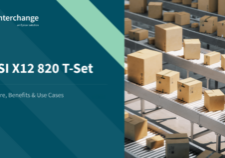What is EDI Mapping?
EDI mapping software sits comfortably within existing EDI integrations to translate documents and data between varying standards and definitions. This process allows these standards to be converted to in-house formats that integrate with existing systems. Fundamentally, EDI mapping is a tool for managing multiple EDI standards within a single EDI system, and for translating EDI-specific standards into formats that other business tools can read and understand.
The introduction of EDI mapping into EDI documents is a significant upgrade from legacy EDI systems that require same-language file formats before communication is possible. This 21st-century capability allows for inclusive and easy communications, regardless of where, or how trading partners are operating.
Fundamentally, EDI mapping is a critical component of any functioning EDI system within a globalised and modern supply chain. Now, more than ever, simplification is essential, regardless of geographical or practical differences in standard format adoption. What’s more, the fact that mapping tools enable mapping in both directions provides end-to-end ease which, right now, companies are relying on more heavily than ever for driving quality and efficient outcomes.
Here, we’re going to break down EDI mapping in more detail, and explain how an updated approach to EDI can transform your supply chain strategy.
Suggested reading: For more details about how EDI can transform commercial outcomes, check out our eBook — The Supply Chain Centred Business.
How does EDI mapping work?
A good way to think about EDI mapping is visually.
Note: If EDI mapping needed to occur in order to translate between different EDI formats, the same basic process would occur within the “Establish Messaging Standard” stage illustrated in the centre of this diagram.
As mentioned, mapping tools are essentially EDI translators, taking any language format, and ensuring that it makes sense across an entire supply chain. Most notably, mapping tools can either:
- Map data on an EDI-to-EDI basis, effectively translating one data format to another (e.g. EDIFACT to ASC X12) to do away with language barriers between business partners already using EDI
- Map data on an EDI-to-other basis, enabling communication even with partners who aren’t versed in EDI themselves by enabling integration with EDI and internal systems (like an ERP or CRM) which might require CSV of XML files.
Within these categories, EDI mapping is not a one-size-fits-all solution. Rather, it’s also necessary to choose between direct EDI and canonical EDI. Direct EDI is the most standard route thanks to its simple and efficient approach that can be tailored to specific needs of a supply chain. This option literally takes a field from one format, and maps it into another. This means that there will be one direct map created for every single trading partner involved in your supply chain, making it easy to pinpoint data sources and accommodate a wide range of EDI message standards.
Canonical (indirect) EDI standardises inbound data into a canonical master format (CMF). In theory, this aims to make mapping simpler by using one map instead of many. However, for a lot of businesses, this introduced an additional layer of complexity to develop and manage. If working with an EDI provider, it’s often more effective to build a bespoke and direct system, rather than deferring to the off-the-shelf capabilities of a canonical EDI approach.
In fact, with most EDI mapping software, a lack of in-house EDI expertise can become a significant issue — complicating a process that, ultimately, should be in place to simplify things. Large scale supply chains come under fire if one partner changes their EDI data structure, meaning that every single map then needs to change to accommodate that switch. This may well be manageable with a supply chain that only covers five partners, but when you’re dealing with 50 or 500 maps, even small changes can cause setbacks that take hours, or days, to manage.
Many companies avoid these supply chain risks by implementing mapping with the help of managed services. In this instance, expert-led EDI mapping integrations are overseen at all times by individuals who know precisely what mapping involves. These bespoke solutions integrate directly within EDI systems to provide greater control and visibility of the entire mapping process. Not to mention that experts are always on-hand to meet data changes across the supply chain in real-time, saving businesses a world of hassle.
Benefits of effective EDI mapping
EDI mapping is a critical tool for simplifying EDI and creating a system that can manage global supply chain complexities. EDI mapping creates a holistic solution that can unite a range of supply chain partners within a single system. Critical benefits this delivers include:
- Automation: While static EDI required in-between manual processes, EDI mapping automatically sends external data to critical internal systems. This creates a repeatable process that shouldn’t require human input at all. Aside from drastically simplifying what could be a complex process, this ensures the removal of human error which, famously, accounts for around 90% of data breaches, and significantly slows processes.
- Connection: Connection, or simplified communications, are one of the most notable mapping benefits. The ability to use flat-file formats that can easily communicate data across even large supply chains is especially beneficial, removing the need for same-language integrations altogether. Where EDI-to-other mapping approaches are concerned, this benefit even opens the door for successful integrations with supply chain partners who are entirely unversed, or ill-equipped, for EDI in general.
- Affordability: EDI mapping stands to significantly cut costs, especially with bespoke solutions that change alongside mapping processes across the supply chain and remove the need for manual input. Not to mention that the ease on offer ensures ongoing happy relationships with the best quality, and value, from trading partners at all times.
Effectively, well-positioned EDI mapping provides the broad-reaching outcomes that your business, and your partners, deserve. As well as helping you to accommodate data formats across your global suppliers, this puts you ahead as a business worth working with, ensuring you can reach the best partners possible, and reap the benefits of doing so business-wide.
EDI mapping and EDI-as-a-service
Where mapping is concerned, what people need most is the ability to go from any format to another, using any-to-any mapper tools and services. Unfortunately, this benefit isn’t as easy as many of us might like from an in-house standpoint (see above), but viable solutions are arising out of current needs.
Most notably, what we here at Data Interchange refer to as EDI-as-a-Service. This is a hybrid approach to EDI that combines cloud-based tools and managed services to deliver a seamless EDI outcome that is tailored to match your specific EDI needs and in-house EDI expertise. This stands to change the game, not only where EDI mapping is concerned, but for easier, better-integrated EDI solutions on the whole — pulling together multiple types of EDI to deliver the right outcome at the right time and overcome EDI implementation issues.
A cloud-based, managed approach to hybrid EDI solutions can provide unparalleled visibility by ensuring you’re able to standardise information flows across your supply chain. All of this leads towards benefits, including:
- Simplified onboarding
- Easier communications
- Smoother processes on the whole
- The ability to adapt and accommodate
Not to mention that a managed approach provides cost-effective, expert-led, and customisable solutions, ensuring that changes in a data structure at one stage of your supply chain don’t have a knock-on, or even noticeable, impact elsewhere. This is as good as direct mapping gets and is guaranteed to not only make your life easier, but to also ensure positive investment loops that take your business from strength to strength.
EDI mapping is central to EDI flexibility
In an age where supply chains span distances like never before, inflexible, and incompatible EDI standards are simply never going to make the cut. Instead, businesses need the ability to approach EDI standards with flexibility in mind, ensuring that they can onboard despite file differences, and regardless of existing EDI experience. Remember, you not only need to consider your own EDI capabilities, but also those of every partner throughout your supply chain.
EDI mapping is critical to EDI flexibility. Capabilities like those offered by our XE EDI mapping tool deliver the translation capabilities needed to connect EDI systems with business-critical applications, and accommodate a range of EDI standards. However, EDI mapping is only one component of overcoming EDI complexity. Ultimately, a broader range of reforms, as captured in the concept of EDI-as-a-Service, brings the types of benefits that businesses really need. If you want to learn more about how to simplify and unify an EDI system, get in touch, or check out our ebook — The Supply Chain Centred Business — to learn more.































































































































